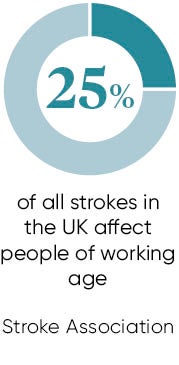 Up to one in ten new strokes occur in people under 45. And the number of strokes in people aged 20 to 64 is increasing, up by 25 per cent from 1990 to 2010 worldwide, according to the Stroke Association.
Up to one in ten new strokes occur in people under 45. And the number of strokes in people aged 20 to 64 is increasing, up by 25 per cent from 1990 to 2010 worldwide, according to the Stroke Association.
Increased prevalence of high blood pressure and diabetes as well as more sedentary lifestyles may be among the factors involved, but in up to half the cases in younger people, the cause is unknown.
Although stroke is mostly associated with the elderly, 2015 UK data reported by the Stroke Association shows that 26 per cent occur in the under-65s and around one in a hundred and fifty in the under-20s. According to the South London Cardiac and Stroke Network, up to 12 per cent of first strokes occur in patients under 45.
About a quarter of all strokes in the UK affect people of working age, according to NHS figures reported by the Stroke Association. National data from the United States, in the Journal of the American Heart Association, shows that over the decade up to 2010, hospitalisation rates for stroke increased by 43.8 per cent in the 25 to 44 age group.
Why the rise?
Just why it is increasing is unclear, although there are many theories. A study reported by the Stroke Association found that 62 per cent of young adults were actively engaged in smoking, alcohol excess or illegal drug use at the time of the stroke.
Dr Anthony Pereira, consultant neurologist at St George’s Hospital in London, and co-author of the Oxford Handbook of Stroke Medicine, says: “There is no clear-cut reason for the rising numbers. The Stroke Association has launched a campaign to raise awareness of warning signs and that may have led to more young people presenting.
“Improved imaging also means that we can detect more strokes, which again may have led to an apparent increase because strokes tend to be milder in young people and not as easily spotted. Younger people now lead more sedentary lifestyles, which could be a factor too.
There are many powerful myths about stroke, for example that it only affects older people
“The prevalence of diabetes and high blood pressure is increasing. Hypertension is the major risk factor for stroke and younger people may be less aware of their blood pressure, but they do need to understand that high blood pressure is very important and needs to be treated early. We have seen people presenting with eye-wateringly high blood pressure.”
Stroke in younger people may also have a different profile. Bigger strokes are more likely to be haemorrhagic or bleeding strokes, rather than the more common ischaemic strokes, where a bloodclot blocks the flow of blood to the brain.
In the under-45s, up to half of strokes are ischaemic compared with 85 per cent in older patients, according to a 2010 report by the South London Cardiac and Stroke Network. That may be because younger adults have a better collateral blood supply that is more able to cope.
Perception
 One of the challenges is that stroke is seen as a disease of older people and may not be considered as a possibility in younger people, which can lead to delays in diagnosis and treatment.
One of the challenges is that stroke is seen as a disease of older people and may not be considered as a possibility in younger people, which can lead to delays in diagnosis and treatment.
“Stroke is often not recognised as a possible diagnosis in young adults,’’ says Dr Richard Perry, consultant neurologist and hyperacute stroke research lead at University College London Hospitals NHS Foundation Trust.
“Patients and many doctors do not think of stroke when a young adult presents with less obvious symptoms, such as sudden unsteadiness. While major symptoms such as loss of movement all down one side of the body will usually be picked up, less specific symptoms can be overlooked in younger people.
“That is a problem because rapid diagnosis is essential for clot-busting drugs to be effective. The London Ambulance Service use a protocol called FAST – Face, Arms, Speech, Time – where crews take notice of these symptoms and ignore age. We would rather screen people who fulfil these criteria and have not had a stroke, rather than miss those who have.”
Alexis Wieroniey, Stroke Association deputy director of policy and influencing, says that increasing recognition of stroke as a possible diagnosis is important. She says: “There are many powerful myths about stroke, for example that it only affects older people, and these stop people from taking action to prevent stroke. The truth is a quarter of strokes happen to people of working age and we all need to change the way we think about this devastating condition.”
There is a financial incentive to detecting stroke early in young people too, because they may survive major strokes for many more years than older patients, incurring greater costs.

Why the rise?
Perception


